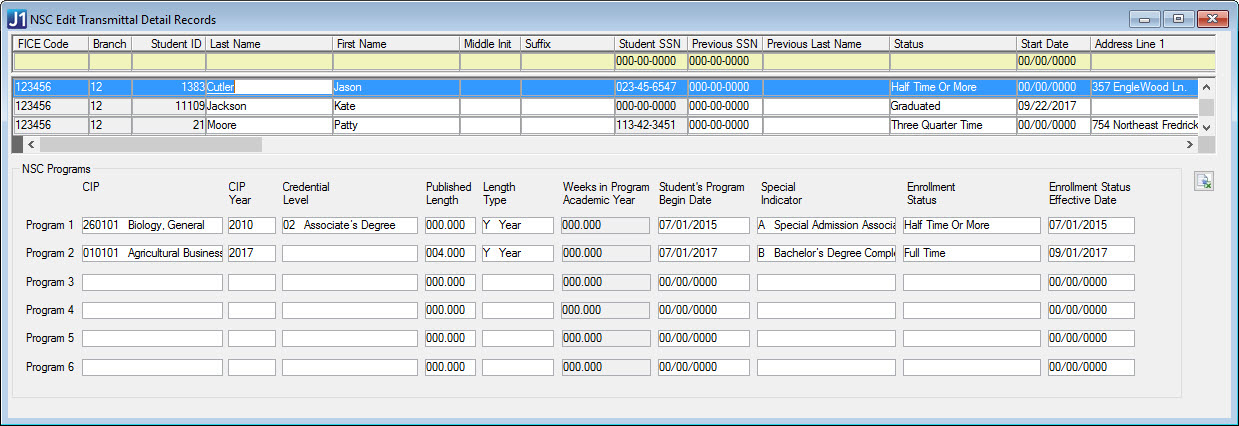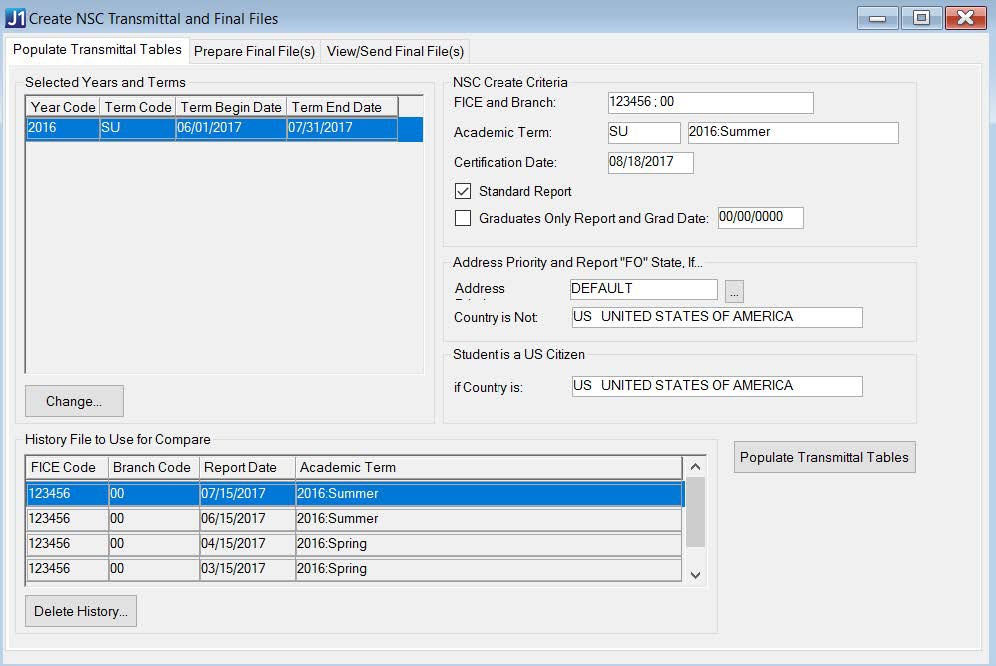
Students' program information is captured on the NSC Edit Transmittal Detail Records window. It acts as an NSC enrollment reporting tool. For up to six programs, you can view and edit these columns:
Column |
Description |
CIP |
Drop-down list |
CIP Year |
Read only |
Credential Level |
Drop-down list |
Published Program Length |
Text field |
Program Length Type |
Drop-down list |
Weeks in Program Academic Year |
Text field |
Student’s Program Begin Date |
MMDDYYYY date format |
Special Indicator |
Drop-down list |
Enrollment Status |
Drop-down list |
Enrollment Status Effective Date |
MMDDYYYY date format |

The NSC program information comes from a database view called the CIP Active Degree View (CIP_ACTIVE_DEGREE_V). A view is a query stored in the database that produces a result set.
The CIP Active Degree View pulls data from several tables in the database, including DEGREE_HISTORY and DEGREE_HISTORY_ARCHIVE, plus multiple definition tables (DEGREE_DEFINITION, MAJOR_MINOR_DEF, CERTIFICATION_DEF, CIP_DEFINITION, etc. (See Reference Information below for a complete list). This produces a result set that includes all of the values necessary for reporting to the National Student Loan Data System (NSLDS), as well as to the National Student Clearinghouse (NSC).
While the CIP Active Degree View pulls most data from the Degree History and corresponding definition tables, the Program Begin Date comes from the Degree History Archive table, based on the latest (most recent) Record Change Date where one or more of the Major 1-4 or Certification 1-4 column values were changed.
Every time a user adds a row to the Degree History table, or makes changes to the data on an existing row, a database trigger (automated process) inserts a row into the Degree History Archive table. The Degree History Archive table contains all of the same columns as the Degree History table, plus a “change” column corresponding to each (for example, MAJOR_1 and MAJOR_1_CHG). The trigger sets the “change” column to 1 if the data in the corresponding column was changed, and to 0 if it wasn’t. For example, if a user backspaces the value ENG in the Major 1 field and types in HIS instead, and then saves, the row in the archive table will record a 1 in the MAJOR_1_CHG column, since Major 1 was changed from English (ENG) to History (HIS).
The CIP Active Degree View compares the rows in the Degree History Archive table to the corresponding rows in the Degree History table, and where the rows match on sequence number and majors 1 – 4 or certifications 1 – 4, where one or more of those eight column values was changed, it looks for the most recent Record Change Date. It then uses the Record Change Date as the Program Begin Date for that Degree History row.
To ensure that the CIP Active Degree View captures the date you want to report as the student’s Program Begin Date, according to NSLDS definitions for Program and Program Begin Date (see the NSLDS Enrollment Reporting Guide), Jenzabar recommends the following best practices:
· Use the Start Date of the first term in which the student enrolls in a program of study, as the Entry Date and Record Change Date on the initial Degree History row; term start dates are identified in the Year Term Subterm window, on the Year/Term tab (YEAR_TERM_TABLE).
· Don’t “recycle” Degree
History rows.
When a students changes their program of study, remove them from the previous
program. Enter the Exit Date and Exit Reason, and deselect the Active checkbox. Then add a row
to the Degree History table to reflect the new program of study.
· Be consistent with your dates:
o When you process a program change after the term has begun, but not after the term’s census date, use that term’s Start Date as both the Entry Date and the Record Change Date.
o When you process a program change after the term has begun and after the census date, use the upcoming term’s Start Date as both the Entry Date and the Record Change Date.
o Be careful to deselect
the Student Division Master checkbox
in the Cross Table Student Information Update pop-up window | Update Entry
Date group. This ensures that it doesn’t overwrite the student’s Original
Entry Date on the Student Division Master row, if you want that column
to reflect the student’s original entrance into the division.

Several factors determine how the Populate Transmittal Tables process calculates the Program Enrollment Status value:
· Is this the first time you are reporting a particular program for a student?
· Is this the first time you are capturing data for the specified term?
· What is the student’s “campus-level” enrollment status (Status column in the top section of the NSC Edit Transmittal Detail Records window)?
· Is the campus-Level enrollment status a “terminal” status, such as Deceased (D), Graduated (G), or Withdrawn (W)?
For the most part, the Populate Transmittal Tables process sets the Program Enrollment Status equal to the campus-level enrollment status, with a couple of exceptions:
· If the student has changed programs, the previous program’s enrollment status will be set to Withdrawn, and the new program’s status will match the campus-level enrollment status.
· If the student was enrolled in more than one program and has completed one but not both (or all) programs, the completed program’s status will be set to Graduated, while the other program’s status will match the campus-level enrollment status
If the student has a value in the Special Status column in the NSC Edit Student Data Records window (NSLC_STUDENT_MAST table), the process will use that value as the campus-level enrollment status. Special status values include Leave of Absence (A), Deceased (D), and Graduated (G).
If the student does not have a special status, the process will use the value found on the most recent row in the NSC Edit Registration Transactions window (NSLC_REG_TRANSACT table), for the year and term you are reporting. The status values found in this table include Full Time (F), Three Quarter Time (Q), Half Time or More (H), Less Than Half Time (L), and Withdrawn (W).
The Populate Transmittal Tables process uses a complex algorithm to calculate the Program Enrollment Status Effective Date, which includes looking at the Program Enrollment Status, the campus-level enrollment status, the history file used for comparison, and the CIP Active Degree View.
First it determines whether this is the first time you are reporting the program for the student. It determines this by comparing the information found in the CIP Active Degree View, to the history file you selected for comparison in the Create NSC Transmittal and Final Files window.

| If | And | Then |
This is the first time you are reporting the program—that is, either the student does not exist or the program does not exist in the history file used for comparison. |
|
The process evaluates the student’s campus-level enrollment status. |
|
The student's campus-level enrollment status = Withdrawn. |
The Certification Date you identified in the Create NSC Transmittal and Final Files window is used. |
|
The student’s campus-level enrollment status <> Withdrawn. |
The Program Begin Date is used. |
| If | And | Then |
This is not the first time reporting the program, but it is the first run for the term. |
|
|
|
The student’s program enrollment status = their campus-level enrollment status, and the status is the same as the history file used for comparison. |
The Program Status Enrollment Effective Date from the history file is used. |
|
The student’s program enrollment status = his/her campus-level enrollment status, but the status is not the same as the history file used for comparison. |
The Term Begin Date is used. |
| If | And | Then |
This is not the first time reporting the program, and this is not the first run for the term. |
|
|
|
The student’s Program Enrollment Status is the same as the history filed used for comparison. |
The Program Status Enrollment Effective Date from the history file is used. |
|
The student’s program status is not the same as the history file used for comparison, and the program enrollment status = the student’s campus-level enrollment status. |
The Status and Start Date for the campus-level enrollment status are used.
These values come from the NSC Edit Student Data Records window (NSLC_STUDENT_MAST table), if the status is · Leave of Absence, · Deceased, or · Graduated. The values come from the NSC Edit Registration Transactions window (NSLC_REG_TRANSACT table), if the status is · Full Time, · Three Quarter Time, · Half Time, · Less Than Half Time, or · Withdrawn. |
|
The student’s program status is not the same as the history file used for comparison, and the program enrollment status <> the student’s campus-level enrollment status. |
The process will either · set the Program Enrollment Status and Program Enrollment Status Effective Date values to match the campus-level enrollment status and date, or · set these values to match the most recent row in the NSC Edit Registration Transactions window for the year and term you are reporting. |
Make sure the data in your history is accurate. The history file you select for comparison determines whether this is the first time you are reporting data for a particular program, and whether the student’s status has changed.
If you find inaccuracies, make corrections in the NSC Edit Transmittal History Records window for the Report Date you are selecting as the History File to Use for Compare for your current file. Then use the Populate Transmittal Tables process again to refresh the data collected for your current file once you’ve saved those corrections. You may also need to make corrections in the NSC system.
| Table Name | Window Name |
CERTIFICATION_DEF |
Certification Definition |
CIP_DEFINITION |
CIP Definition |
DEGREE_DEFINITION |
Degree Definition |
DEGREE_HISTORY |
Student Information | Degree tab |
DEGREE_HISTORY_ARCHIVE |
Student Information | Degree tab | right-click option |
MAJOR_MINOR_DEF |
Major/Minor Definition |
NSLC_CIP_CREDENTIAL_LVL |
CIP Definition | NSC Credential Levels tab |
NSLC_PROG_CRED_LVL_DEF NSC |
Program Credential Level Definition |
NSLC_PROG_LENGTH_TYP_DEF |
NSC Program Length Type Definition |
NSLC_PROG_SPECIAL_DEF |
NSC Special Program Definition |
TABLE_DETAIL |
Maintain Table Values | Column Name: 'exit_reason' |
| Dates | Window Name | Legend |
Special Status Date |
Campus-level Enrollment Status in (‘A’,’D’,’G’) AND Program Enrollment Status = Campus-level Enrollment Status |
A = Leave of Absence D = Deceased G = Graduated |
Transaction Status Date |
Campus-level Enrollment Status in (‘F’,’Q’,’H’,’L’) AND Program Enrollment Status = Campus-level Enrollment Status AND Campus-level Enrollment Status Date is not NULL AND There are no history rows to compare to |
F = Full Time Q = Three Quarter Time H = Half Time L = Less Than Half Time |
History Effective Date |
Campus-level Enrollment Status in (‘F’,’Q’,’H’,’L’) AND Program Enrollment Status = Campus-level Enrollment Status AND Status = History Status |
Same as above |
Term Begin Date |
Campus-level Enrollment Status in (‘F’,’Q’,’H’,’L’) AND Program Enrollment Status = Campus-level Enrollment Status AND Status <> History Status |
Same as above |
Certification Date |
Campus-level Enrollment Status = ‘W’ AND This is the first time you are reporting the program OR The program is not found in CIP Active Degree View |
W = Withdrawn |